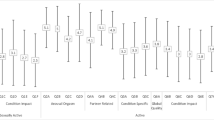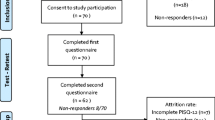Abstract
Introduction
This paper provides a detailed discussion of the psychometric analysis and scoring of a revised measure of sexual function in women with pelvic floor disorders (PFD): the Pelvic Organ Prolapse Incontinence Sexual Questionnaire, IUGA-Revised (PISQ-IR).
Methods
Standard tools for evaluating item distributions, relationships, and psychometric properties were used to identify sub-scales and determine how the sub-scales should be scored. The evaluation of items included a nonresponse analysis, the nature of missingness, and imputation methods. The minimum number of items required to be answered and three different scoring methods were evaluated: simple summation, mean calculation, and transformed summation.
Results
Item nonresponse levels are low in women who are sexually active and the psychometric properties of the scales are robust. Moderate levels of item nonresponse are present for women who are not sexually active, which presents some concerns relative to the robustness of the scales. Single imputation for missing items is not advisable and multiple imputation methods, while plausible, are not recommended owing to the complexity of their application in clinical research. The sub-scales can be scored using either mean calculation or transformed summation. Calculation of a summary score is not recommended.
Conclusion
The PISQ-IR demonstrates strong psychometric properties in women who are sexually active and acceptable properties in those who are not sexually active. To score the PISQ-IR sub-scales, half of the items must be answered, imputation is not recommended, and either mean calculation or transformed sum methods are recommended. A summary score should not be calculated.




Similar content being viewed by others
References
Rogers RG et al. (2013) A revised measure of sexual function in women with pelvic floor disorders (PFD); the Pelvic Organ Prolapse Incontinence Sexual Questionnaire, IUGA-revised (PISQ-IR). Int Urogynecol J. doi:10.1007/s00192‐012‐2020‐8
Campbell DT, Russo MJ (2001) Social measurement. Sage, Thousand Oaks, p 509
Campbell DT, Overman ES (1988) Methodology and epistemology for social science: selected papers. University of Chicago Press, Chicago, p 609
Cole DA, Howard GS, Maxwell SE (1981) Effects of mono-versus multiple operationalization in construct validation efforts. J Consult Clin Psychol 49(3):393–405
Shepard RN, Romney AK, Nerlove SB (1972) Multidimensional scaling; theory and applications in the behavioral sciences, vol. 1: Theory. Seminar Press, New York
Kruskal JB, Wish M (1993) Multidimensional scaling. Sage, Beverly Hills
Summers GF (1970) Attitude measurement. Rand McNally, Chicago, p 568
Nunnally JC, Bernstein IH (1994) Psychometric theory, 3rd edn. McGraw-Hill Series in Psychology. McGraw-Hill, New York, p 752
Gorsuch RL (1974) Factor analysis. Saunders, Philadelphia, p 370
Jackson DJ, Borgatta EF (1981) Factor analysis and measurement in sociological research: a multi-dimensional perspective. Sage Studies in International Sociology. Sage, Beverly Hills, p 313
McKnight PE (2007) Missing data: a gentle introduction. Methodology in the social sciences. Guilford Press, New York, p 251
Gorsuch RL (1983) Factor analysis, 2nd edn. L. Erlbaum Associates, Hillsdale, p 425
Cronbach LJ (1951) Coefficient alpha and the internal structure of tests. Pscyhometrika 16:197–334.
Allison PD (2002) Missing data. Sage University papers: Quantitative Applications in the Social Sciences. Sage, Thousand Oaks, p 93
Little RJA, Rubin DB (2002) Statistical analysis with missing data, 2nd edn. Wiley Series in Probability and Statistics. Wiley, Hoboken, p 381
Groves RM, Dillman DA, Eltinge JL, Little RJA (2002) Survey nonresponse. Wiley Series in Survey Methodology. Wiley, New York, p 500
Allison PD (2000) Multiple imputation for missing data: a cautionary tale. Sociol Methods Res 28(3):301–309
Howell DC (2007) The treatment of missing data. In: Outhwaite W, Turner SP (eds) The Sage handbook of social science methodology. Sage, London
Hox J, De Leeuw E, Dillman DA (2008) International handbook of survey methodology. Lawrence Erlbaum, Philadelphia
Särndal C-E, Lundström S (2005) Estimation in surveys with nonresponse. Wiley, Hoboken
Little RJA, Rubin DB (2002) Statistical analysis with missing data, 2nd edn. Wiley, Hoboken
Madow WG, Olkin I, Rubin DB (1983) Incomplete data in sample surveys. Academic Press, New York, pp 1–2
Van Ginkel JR, van der ark LA, Sijtsma K (2007) Multiple imputation of item scores in test and questionnaire data, and influence on psychometric results. Multivariate Behav Res 42(2):387–414
Spector PE (1992) Summated rating scale construction: an introduction. Sage University Papers: Quantitative Applications in the Social Sciences, no. 07-082. Sage, Newbury Park, p 72
Ware JEJ, Kosinski M, Dewey JE (2000) How to score version 2 of the SF-36 health survey. QualityMetric, Lincoln
Dillman DA, Smyth JD, Christian LM (2009) Internet, mail, and mixed-mode surveys: the tailored design method, 3rd edn. Wiley, Hoboken
Krosnick JA (1991) Response strategies for coping with the cognitive demands of attitude measures in surveys. Appl Cogn Psychol 5(3):213–236
Krosnick JA, Narayan S, Smith WR (1996) Satisficing in surveys: initial evidence. New Directions for Program Evaluation 70:29–77
Snider JG, Osgood CE (1969) Semantic differential technique; a sourcebook. Aldine, Chicago, p 681
Shrive FM, Stuart H, Quan H, Ghali WA (2006) Dealing with missing data in a multi-question depression scale: a comparison of imputation methods. BMC Med Res Methodol 6(57):1–10
Rogers R, Kammerer-Doak D, Villarreal A, Coates K, Qualls C (2001) A new instrument to measure sexual function in women with urinary incontinence or pelvic organ prolapse. Am J Obstet Gynecol 184(4):8
Wonnacott TH, Wonnacott RJ (1981) Regression, a second course in statistics. Wiley Series in Probability and Mathematical Statistics. Wiley, New York, p 556
Blalock HM (1974) Measurement in the social sciences: theories and strategies. Aldine, Chicago, p 464
Acknowledgements
This study was reviewed and approved by the University of Minnesota IRB #0908 M70626. This study was funded by the International Urogynecological Association. University of Minnesota, Grant Award Number CON000000021500, Todd H Rockwood, PhD, PI.
Conflict of interest
None.
Author information
Authors and Affiliations
Corresponding author
Additional information
A related editorial can be found at doi:10.1007/s00192‐012‐1952‐3.
Appendix A: transformed sum scoring for the PISQ-IR
Appendix A: transformed sum scoring for the PISQ-IR
Example—scale: NSA-GQ not sexually active: global quality rating
Item | Response | Reverse response | Item score | Minimum determination | Maximum determination |
|---|---|---|---|---|---|
Q4a: satisfied to dissatisfied | 2 (1 to 5) | 6–2 (response) | 4 | 1 (enter 1 if answered) | 5 (enter 5 if answered) |
Q4b: adequate to inadequate | 3 (1 to 5) | 6–3 (response) | 3 | 1 (enter 1 if answered) | 5 (enter 5 if answered) |
Q5a: I feel frustrated by my sex life | 3 (1 to 4) | 3 | 1 (enter 1 if answered) | 4 (enter 4 if answered) | |
Q6: Overall, how bothersome is it to you that you are not sexually active? | − (1 to 4) | 5– = (response) | – | – (enter 1 if answered) | – (enter 4 if answered) |
10 | 3 | 14 | |||
Sum | Sum: minimum | Sum: maximum | |||
Range: 11 = 3 –14 | |||||
(minimum) to (maximum) | |||||
Example—scale: SA-AO sexually active: arousal, orgasm
Item | Response | Reverse response | Item score | Minimum determination | Maximum determination |
|---|---|---|---|---|---|
Q7: How often do you feel sexually aroused (physically excited or turned on) during sexual activity? | 3 (1 to 5) | 3 | 1 (enter 1 if answered) | 5 (enter 5 if answered) | |
Q8a: fulfilled | 2 (1 to 5) | 2 | 1 (enter 1 if answered) | 5 (enter 5 if answered) | |
Q10:Compared with orgasms you have had in the past, how intense are your orgasms now? | 3 (1 to 5) | 3 | 1 (enter 1 if answered) | 5 (enter 5 if answered) | |
Q11:How often do you feel pain during sexual intercourse? (If you don’t have intercourse check this box X and skip to the next item) | 1 (1 to 5) | 6–1 = (box checked value is 1) | 5 | 1 (enter 1 if answered) | 5 (enter 5 if answered) |
Scoring note: If the box is checked enter 1 as response value | |||||
13 sum | 4 sum: minimum | 25 sum: maximum | |||
Range: 21 = 4–25 | |||||
(minimum) to (maximum) | |||||
Example—scale: NSA-CS not sexually active: condition-specific

Scoring—not sexually active
Scale: NSA-PR not sexually active: partner-related

Scale: NSA-CS not sexually active: condition-specific

Scale: NSA-GQ not sexually active: global quality rating

Scale: NSA-CI: Not sexually active: condition impact

Scoring—sexually active
Scale: SA-AO sexually active: arousal, orgasm

Scale: SA-PR sexually active: partner-related

Scale: SA-CS sexually active: condition-specific

Scale: SA-GQ sexually active: global quality rating

Scale: SA-CI sexually active: condition impact

Scale: SA-D sexually active: desire

Rights and permissions
About this article
Cite this article
Rockwood, T.H., Constantine, M.L., Adegoke, O. et al. The PISQ-IR: considerations in scale scoring and development. Int Urogynecol J 24, 1105–1122 (2013). https://doi.org/10.1007/s00192-012-2037-z
Received:
Accepted:
Published:
Issue Date:
DOI: https://doi.org/10.1007/s00192-012-2037-z




